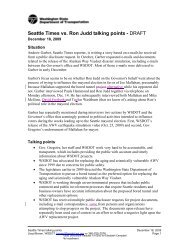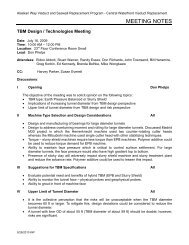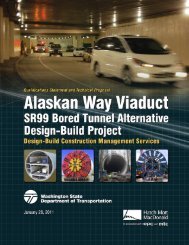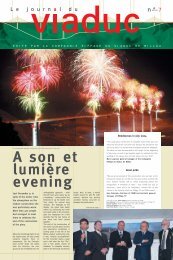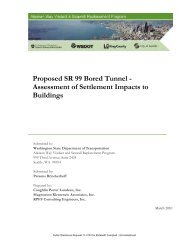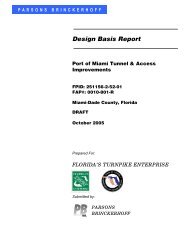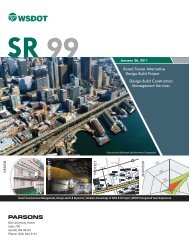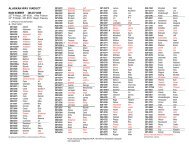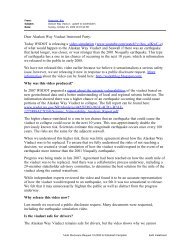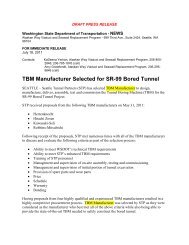herrenknecht ag softground tbms > 40 ft - SCATnow
herrenknecht ag softground tbms > 40 ft - SCATnow
herrenknecht ag softground tbms > 40 ft - SCATnow
Create successful ePaper yourself
Turn your PDF publications into a flip-book with our unique Google optimized e-Paper software.
MIXSHIELDS<br />
The making of the<br />
Mixshield – Part 1<br />
In the first of a two-part series, Werner Burger, head of design and<br />
engineering, and Gerhard Wehrmeyer, director of traffic tunnelling, for<br />
Herrenknecht AG, examine the development of the modern Mixshield<br />
Since its initial introduction, in 1985,<br />
the Mixshield TBM has taken on<br />
an essential role within the world<br />
of mechanical tunnel excavation.<br />
With its ability to operate as a classic slurryshield,<br />
or change to Open or Earth Pressure<br />
Balance (EPB) mode mid-drive, the<br />
Mixshield offers a unique concept for dealing<br />
with mixed ground excavation conditions.<br />
In order to appreciate how these<br />
machines have evolved, this article looks at<br />
the history and development of Mixshield<br />
technology over recent decades and the<br />
impact this has had on the underground<br />
construction industry.<br />
even today, the term “Mixshield” is still used<br />
for “slurry only” machines as well as for<br />
convertible shields. In all cases, however, the<br />
use of a submerged wall/pressure bulkhead<br />
combination, to create an air bubble for face<br />
pressure control, has remained an essential<br />
design feature for this type of machine.<br />
Right & below: Fig 1 - The HERA Mixshield<br />
Cutting<br />
wheel<br />
Submerged<br />
wall<br />
Shield<br />
skin<br />
Air lock Shield tail seal Segment<br />
Push<br />
transport<br />
cylinder Erector<br />
Development of technology<br />
The first European attempts to develop a<br />
bentonite shield began in England in the<br />
early 1960s, leading to the excavation of a<br />
short experimental tunnel in London, in<br />
1971. German contractor Wayss & Freyt<strong>ag</strong><br />
took these initial ideas and built upon them,<br />
incorporating an air bubble principle to<br />
control and regulate face support pressure.<br />
These early machines were mainly used in<br />
gravel and sand under lower water pressure,<br />
such as the Wilhelmsburg CSO tunnel, in<br />
Germany, which was completed in 1974.<br />
The shields were equipped with a centre<br />
sha<strong>ft</strong> drive and light spoke-type cutterheads<br />
with square dr<strong>ag</strong> tools, reflecting their limited<br />
range of application at that st<strong>ag</strong>e.<br />
With a view to finding an alternative to<br />
conventional compressed air excavations,<br />
which were common at the time, Wayss &<br />
Freyt<strong>ag</strong> concentrated on the design of face<br />
support systems and the development of a<br />
tail shield seal that would stand up to the<br />
rough conditions of mechanical excavation.<br />
In parallel with these developments, the<br />
evolution of water-resistant single-shell<br />
concrete segmental linings occurred.<br />
Early Mixshield concepts focused both on<br />
the development of a shield that would<br />
provide a slurry supported tunnel face and<br />
also an open shield that could enable a<br />
change of operational mode [1] . That is why,<br />
Grill<br />
Front<br />
section<br />
Articulation<br />
cylinder<br />
Middle<br />
section<br />
Coupling<br />
joint<br />
Shield<br />
tail<br />
The Mixshield is ultimately distinguished<br />
by the following features:<br />
• A modular design that allows adaption to<br />
different modes of operation (slurry, open,<br />
and EPB) for different projects, or a fullyequipped<br />
machine for changes mid-drive<br />
• Centre-free cutterhead drive with threeaxis<br />
roller bearing for a centrally arranged<br />
muck transportation system (screw or belt)<br />
• Centre-free cutterhead drive to<br />
accommodate various media (water,<br />
bentonite, hydraulics, electrics, etc) into<br />
the cutterhead and excavation chamber<br />
via a rotary joint<br />
• Integration of a cutterhead support system<br />
with axial and radial articulation by means<br />
of a spherical bearing<br />
Return line<br />
Feed line<br />
First trailer<br />
The first application of a true Mixshield<br />
machine was at the HERA tunnel, in<br />
Hamburg, in 1985. This 6.2km-long project<br />
accomplished advance rates of up to<br />
20m/day. The developments introduced<br />
proved successful, following a few<br />
adaptations during tunnelling, and confirmed<br />
the suitability of the new design.<br />
Like other early Mixshields, the HERA<br />
machine had a cutterhead that tilted forward<br />
at 3°. The idea was that a slightly inclined<br />
face would help with face stability. However,<br />
with growing experience and confidence in<br />
the principle of a bentonite-supported face,<br />
this mechanically cumbersome configuration<br />
eventually disappeared in favour of vertically<br />
mounted cutterheads.<br />
MAY 2008 Tunnels & Tunnelling International 35




